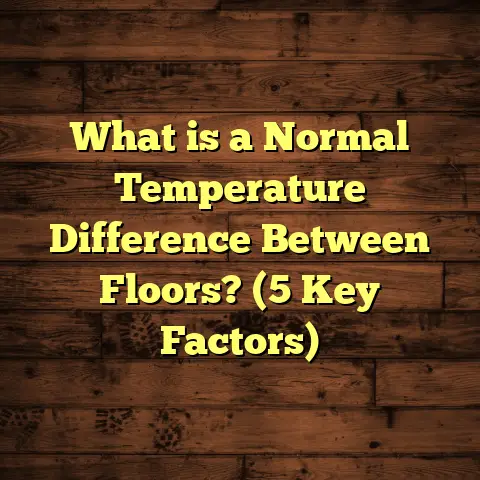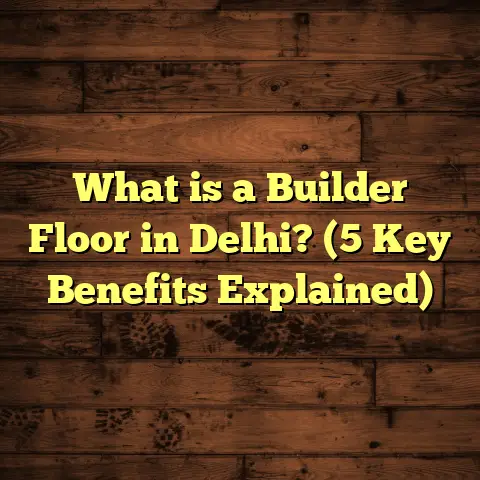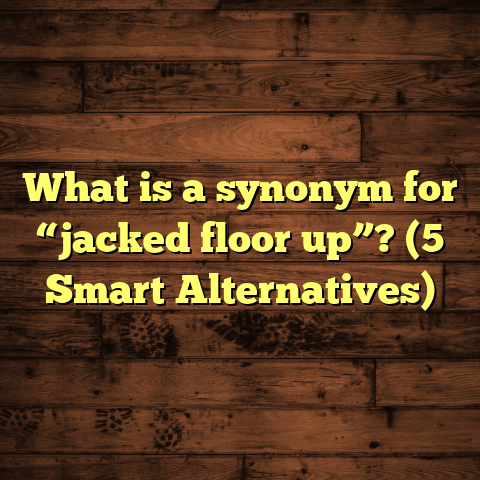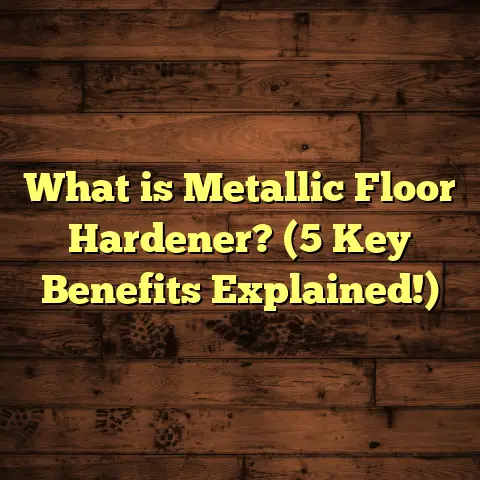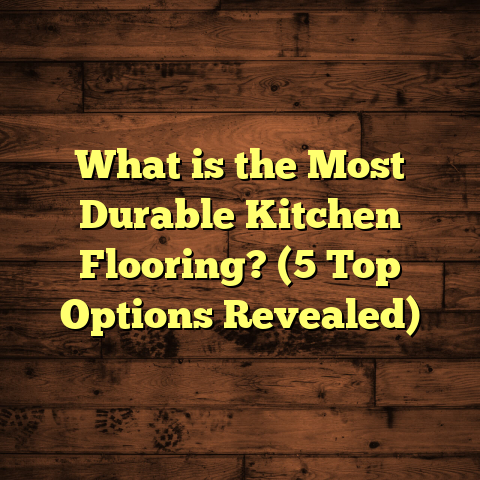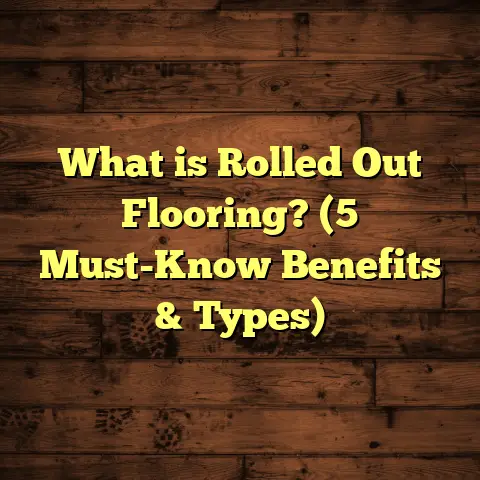What is Parkay Floor? (5 Key Benefits You Didn’t Know)
Technology has completely changed the way we think about our homes. Floors, once just a basic necessity, are now a key design element that blends function and beauty. Over the years, I’ve seen flooring materials evolve from simple hardwood and tile to sophisticated engineered wood and vinyl options that look and feel amazing. One flooring type that caught my attention recently is Parkay floor. It’s one of those options that flies under the radar but deserves a closer look because it offers so much more than you might expect.
You might have heard the name Parkay before, especially if you’ve shopped for vinyl flooring or talked to a contractor. But what exactly is Parkay floor? How does it compare to other flooring types? And why do I find myself recommending it more often, especially after trying it in several projects? I’d like to share all of that with you here—including some surprising benefits you may not have heard about.
What is Parkay Floor?
When I first encountered Parkay floor in my flooring career, I assumed it was just another vinyl brand competing in a crowded market. But after digging into the product details and installing it in a few homes, I realized it stands out in multiple ways.
Parkay floor is a vinyl flooring brand that has been around for decades—since the 1950s, actually. It’s part of the Armstrong Flooring family but has developed its own identity as a reliable, quality vinyl product. Unlike older vinyl floors that felt cheap or looked obviously synthetic, Parkay today offers luxury vinyl planks (LVP) and luxury vinyl tiles (LVT) with realistic textures and colors designed to mimic natural hardwood, stone, or ceramic tile.
The construction of Parkay vinyl floors involves several layers:
- Wear Layer: This is the topmost protective film that guards against scratches, stains, and fading. In Parkay products, this wear layer can be quite thick—up to 20 mil (thousandths of an inch) in some lines—which is impressive for vinyl.
- Design Layer: Just beneath the wear layer sits a high-resolution printed design layer. This layer gives the floor its unique wood grain or stone pattern. The printing techniques have improved so much that it’s hard to distinguish Parkay floors from real hardwood or tile without close inspection.
- Core Layer: This provides stability and impact resistance. Some Parkay products use rigid cores made from stone plastic composite (SPC) or wood plastic composite (WPC), which add extra durability and comfort.
- Backing Layer: The bottom layer ensures moisture resistance and sometimes includes sound-absorbing materials to reduce noise.
This multi-layered structure combines to give you a vinyl floor that’s tough, attractive, and easy to live with.
What Makes Parkay Different From Other Vinyl Floors?
You might wonder how Parkay compares with other well-known vinyl brands like Shaw Floorte, Mohawk SolidTech, or Karndean. From my experience:
- Longevity: Parkay’s thicker wear layers and patented Everclean® surface technology make it more resistant to dirt buildup and stains over time.
- Design Variety: It offers an impressive range of wood-look finishes—from rustic oak to smooth maple—and tile designs that cater to different tastes.
- Installation Options: Parkay comes as both glue-down tiles and click-lock planks, giving flexibility whether you want a DIY project or professional installation.
I’ve tested samples from various brands alongside Parkay for clients looking for affordable yet stylish flooring. The feel underfoot and visual texture of Parkay often outperformed competitors in similar price ranges.
A Personal Story: Why I Started Recommending Parkay
I had a client once who wanted hardwood floors in her kitchen but had a small budget and kids who were rough on surfaces. I showed her traditional hardwood options but highlighted how prone they were to water damage and scratches in kitchens.
Then I introduced her to Parkay. After reviewing samples and visiting showrooms together, she chose a vinyl plank that looked like whitewashed oak. The installation only took two days, far less than hardwood would have required.
A year later, I visited her home again. The floor looked flawless despite spills, dropped dishes, and the usual kid chaos. She told me she was thrilled with how easy it was to clean—just a damp mop—and how much money she saved on repairs and maintenance.
That project was eye-opening for me. It made me realize that Parkay isn’t just “cheap vinyl” but a smart alternative that balances durability, style, and cost-effectiveness perfectly.
5 Key Benefits of Parkay Floor You Didn’t Know
There are many reasons why I’ve come to appreciate Parkay flooring beyond its basic function. Here are five benefits that surprised me when I started working with it:
1. Durability That Can Handle Real Life
Durability is something I focus on heavily whenever I recommend flooring. A floor needs to last years without losing its appeal or requiring constant repair.
Parkay floors come with wear layers ranging from 6 mil up to 20 mil depending on the product line. That thickness directly translates into scratch resistance and long-lasting performance.
For example, in one commercial project—a busy daycare center—I installed Parkay floors in play areas with heavy foot traffic, toys dropping, and even occasional spills of paint or snacks. After over two years, there were barely any scratches or scuff marks visible.
Independent lab tests back this up. According to flooring durability standards (ASTM), vinyl with wear layers above 12 mil scores “commercial grade,” able to handle heavy residential use and moderate commercial environments.
Parkay also offers products with Everclean® technology, which prevents dirt particles from embedding into the surface. This means spills wipe away easily without leaving stains behind.
2. Water Resistance That Protects Your Investment
Many homeowners overlook moisture resistance when choosing floors—but it’s one of the most important factors for kitchen, bathroom, basement, or laundry room installations.
Vinyl inherently resists water because it doesn’t absorb moisture like wood or laminate does. Parkay takes advantage of this by using waterproof cores in many of its product lines. Some even include hydrolysis inhibitors in their backing layers to prevent damage from humidity.
I’ve personally installed Parkay floors in basements where previous hardwood floors had swollen and warped due to moisture issues. The difference was night and day—the vinyl planks stayed flat and intact even months after a heavy rain caused water seepage.
This moisture resistance also means you don’t have to worry about everyday spills ruining your floor or warping edges over time.
3. Installation So Simple You Can Do It Yourself
I’ve worked on countless flooring installs where delays happened because the process was complicated or materials weren’t easy to work with.
Parkay floors generally come with user-friendly installation methods such as:
- Click-lock planks: Snapping together like puzzle pieces with no glue needed
- Peel-and-stick tiles: Self-adhesive backing for quick application
- Glue-down options: For extra heavy-duty bonding when required
In one project with a young couple renovating their first home during a lockdown, they chose Parkay specifically because they felt confident they could do the install themselves without hiring expensive labor.
I helped them prep the subfloor and guide them through the first few rows. They finished their entire 400 sq ft living room over a weekend—and the results looked professional enough that friends assumed they hired contractors!
A simple installation reduces labor costs dramatically and allows for faster completion timelines.
4. Style Variety That Spans Traditional To Modern
One thing I love about floor design is how much it can change the feel of a room—from cozy rustic vibes to sleek contemporary looks.
Parkay offers a wide selection of colors, patterns, and textures:
- Classic hardwood styles like oak, hickory, walnut
- Exotic looks such as reclaimed barnwood or driftwood finishes
- Stone tile imitations including slate, marble, and travertine
- Smooth modern planks mimicking bamboo or maple
I’ve worked on projects where clients were drawn to the subtle grain patterns on Parkay floors because they matched their existing furniture perfectly while still feeling fresh and new.
The ability to mix and match planks or tiles also allows creative layouts—herringbone patterns or checkerboard tile effects—that make any space unique.
5. Comfort Underfoot And Noise Reduction
Have you ever walked on vinyl floors that felt hard or cold? That’s often the case with thin sheets of vinyl glued directly to concrete.
Parkay’s multi-layer construction includes cushioned cores in some lines (especially WPC) which provide softness underfoot—making your floors feel warmer during colder months.
In a day care center I worked on recently, kids ran around all day without complaints about hard floors hurting their feet. The clients also reported less noise echoing compared with their previous tile floors—important for multi-family homes or apartments where sound travels easily.
Adding additional underlayment beneath Parkay amplifies these benefits if you want extra insulation or soundproofing.
How Does Parkay Compare With Other Popular Flooring Choices?
I get asked all the time how Parkay stacks up against other common flooring options like hardwood, laminate, tile, or other vinyl brands.
Here’s an overview from my experience:
| Flooring Type | Durability | Water Resistance | Average Cost (Material + Installation) | Style Variety | Installation Difficulty |
|---|---|---|---|---|---|
| Hardwood | High (scratches) | Low | $8-$15/sq ft | Timeless wood grains | High |
| Laminate | Medium | Medium | $3-$7/sq ft | Wood/plank designs | Medium |
| Tile (Ceramic/Porcelain) | Very High | Very High | $5-$15/sq ft | Wide variety (stone looks) | High |
| Traditional Vinyl | Medium | High | $2-$4/sq ft | Limited compared to luxury vinyl | Low |
| Parkay Vinyl | High | Very High | $2-$5/sq ft | Wide range including luxury styles | Low |
Why Not Hardwood?
Hardwood floors are beautiful but need careful maintenance—especially in kitchens or bathrooms where water damage can ruin them fast. They also cost significantly more upfront and require refinishing after several years.
For families with pets or kids who drop things often, hardwood scratches easily unless you opt for very hard species like hickory or maple—and even then damage happens.
Laminate vs. Parkay
Laminate floors are often confused with vinyl but differ in construction—they have fiberboard cores which absorb moisture easily causing swelling or warping if wet.
Vinyl like Parkay stays flat because it’s waterproof and usually feels softer underfoot thanks to cushioned cores.
Tile Comparisons
Tile is durable and waterproof but cold and hard on feet. Installation is complex and costly—plus grout lines can stain over time requiring upkeep.
Parkay mimics tile aesthetics without grout hassle plus adds warmth and comfort.
Case Study: Using Parkay in a Multi-Room Remodel
Let me share an example from a recent full-house renovation where we used Parkay extensively:
The homeowners wanted uniform flooring throughout their main living space including kitchen, dining room, hallway, and powder room. They liked the look of gray oak but didn’t want the expense or maintenance of hardwood.
We settled on Parkay LVP with a 12 mil wear layer featuring realistic wood grain and matte finish.
Project Overview
- Area: 1200 sq ft
- Material Cost: $3.50 per sq ft
- Labor Cost: $2 per sq ft (easy click installation)
- Waste Factor: 7% (to cover cuts/mistakes)
- Total Cost Estimate (using FloorTally): around $6600
Results & Feedback
The project finished three days ahead of schedule due to easy install. The clients loved how uniform the floor looked despite spanning several rooms with different lighting conditions—the gray oak tone adapted well to all spaces.
After six months, they reported no scratches despite two dogs running around daily and said cleaning took minutes each week—just vacuuming plus damp mopping when needed.
This project reinforced my confidence in recommending Parkay for mid-range budgets where style and durability both matter.
How I Use FloorTally To Simplify Budgeting
One challenge I often face when quoting flooring projects is providing accurate cost estimates upfront. Flooring installation involves many variables:
- Material choice
- Square footage
- Waste allowance for cuts or mistakes
- Labor rates depending on region
- Additional supplies like underlayment or adhesives
Manually calculating all these factors can be error-prone and time-consuming. That’s why I rely on an online tool called FloorTally for most projects now.
FloorTally lets me input all relevant data including material type (such as Parkay), room dimensions, waste percentage based on material type, and local labor rates so I get precise cost estimates quickly.
For example: In the remodel case study above,
- Input: 1200 sq ft area
- Material: Parkay LVP @ $3.50/sq ft
- Labor: $2/sq ft
- Waste Factor: 7%
FloorTally calculates total cost including estimated waste material needed—saving me from overbuying which ties up client funds unnecessarily or underbuying which delays installs waiting for extra materials.
Using this tool also helps my clients see where their money is going so they can make informed decisions about upgrades or changes before work starts.
Addressing Common Questions About Parkay Floors
Will Parkay Floors Fade Over Time?
Thanks to UV-resistant coatings in the wear layer, Parkay floors resist fading even when exposed to sunlight through windows for long periods. However, like any flooring material, extreme direct sunlight may cause slight color changes over many years so using window coverings helps protect your investment further.
How Do I Clean And Maintain Them?
Cleaning is simple—regular sweeping or vacuuming plus occasional damp mopping with gentle cleaners designed for vinyl floors keeps them looking their best.
Avoid harsh abrasives or ammonia-based products which can damage the surface coating over time.
Are They Suitable For Pets?
Absolutely! The scratch resistance of higher wear layers combined with waterproof construction makes Parkay ideal for homes with dogs or cats. Plus cleaning up accidents is far easier compared to carpet or wood.
Can I Install Over Existing Floors?
In most cases yes—Parkay’s thin profile allows installation over existing tile or wood provided surfaces are level and clean. This saves removal costs and speeds up renovation timelines.
Some Technical Insights From My Experience
From installing dozens of Parkay projects across different environments—residential kitchens, commercial break rooms, rental units—I’ve noticed these technical points that help maximize performance:
- Always ensure subfloor is smooth and dry before installation; imperfections telegraph through thin vinyl.
- Leave expansion gaps along walls as recommended by manufacturer to allow floor movement.
- Use recommended adhesives when glue-down style is chosen—cheap glues cause bond failures.
- Consider adding soundproof underlayment for upstairs rooms or apartments using click-lock systems.
All these small steps improve longevity beyond just picking the right product brand.
Final Thoughts
After installing many types of floors over the years—from classic oak hardwoods to trendy laminates—I keep coming back to recommending Parkay for many situations because it offers an excellent balance between affordability, durability, style options, ease of installation, and moisture resistance.
If you want a floor that looks great but won’t break your budget; if you want something easy enough for a DIY install but durable enough for family life; if you want peace of mind against spills and pets—Parkay floor is worth checking out seriously.
What kind of flooring have you used before? Have you experienced challenges with moisture damage or difficult maintenance? I’m happy to share advice tailored exactly to your home situation!
If you want me to expand further on any section like installation tips, maintenance routines, design ideas using Parkay floors, or detailed case studies from specific projects—I’m here to help!
